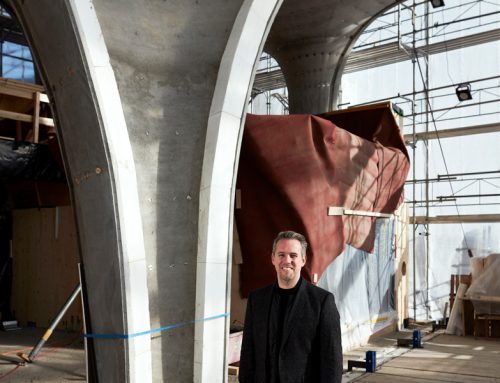 From the day it was founded on the discovery of gold 128 years back, Joburg has always lived on its wits – the city of the bold, the city of opportunity, the city on the make. For some, it’s Egoli where fortunes have been made; for others, the dream has dissolved into lives of inner city adversity, daily tested by crime, grime and toil.
From the day it was founded on the discovery of gold 128 years back, Joburg has always lived on its wits – the city of the bold, the city of opportunity, the city on the make. For some, it’s Egoli where fortunes have been made; for others, the dream has dissolved into lives of inner city adversity, daily tested by crime, grime and toil.
Over the decades Joburg’s inner city has had its distinct ups and its undeniable downs. Many of us want to believe the down side of its bipolar character can be fixed and that it is once again on the rise. We want to believe that all the efforts of the City and all the contributions of the Wits academics and alumni who are committed to its restoration and reinvention will succeed. Right now though, the pendulum of hope and despair still swings between “It’s working!” and “It’s a disaster!”
Visitors to the inner city reflect this response. They either describe it as “dirty and dangerous” or an “exciting, unexpected find”.
To get a firsthand feel, I head into the inner city with my WITSReview peers from Wits University: Nicole Sterling on camera and Deborah Minors on street savvy, armed with umbrellas because it’s pelting down. Wits’ location alongside the inner city ties it to the fortunes of the City of Gold.
We are fortunate to have as our guide urban designer Andrew Luke, a director at the Melville-based architecture and urban design company GAPP.
Luke graduated from Wits in 1989 with a BSc in Town Planning and subsequently did his Masters in Urban Design at the University of Westminster in the United Kingdom. He’s wholeheartedly committed to the inner city, where GAPP has done plenty of work – from the FNB Bank City to restoring old mining hostels and converting them from single quarters into family accommodation.
GAPP has also worked with the Johannesburg Development Agency on upgrading the public environment, including widening the city’s pavements and creating pedestrian walkways, seating areas, good lighting, artwork trails and people-friendly parks.
“Upgrading the public environment is imperative in cities because the population densities are so high that most people live outside the buildings and in the streets, which become their lounge, eating and meeting place and office,” Luke explains.
Upgraded urban environments also attract private sector investment because the area looks more appealing, and this leads to expanded areas of regeneration.
Regrettably, the opposite has happened in parts of the inner city where large numbers of squatters have occupied former office and apartment buildings and created overcrowded informal settlements.
This raises a string of questions from here to Bree Street, but more of this later because we need to get started on our tour.
First stop Fordsburg
First stop is Fordsburg to get the lie of the land.
The inner city spans an area of approximately 1800 hectares and includes Johannesburg’s traditional central business district or city centre (where the Carlton Centre, 223 metres high, is still Africa’s tallest building), Joubert Park, Marshalltown, Braamfontein, Newtown, Fordsburg, Bellevue, Yeoville, Berea, Hillbrow, Troyeville, Bertrams and Doornfontein.
We head through the Fordsburg subway, where Luke surprises us with the delightful metal sculptures that line the old walkway. People who once lived in the area known as Fietas would take this route to the shops or to see a movie at one the five cinemas in neighbouring Fordsburg.
A place called Fietas
Fietas was one of the oldest communities in Johannesburg, and one of the first multi-racial areas established under the government of Paul Kruger in 1893. From the mid-1950s things changed dramatically when Fietas residents were forcibly removed to Lenasia and Soweto, and a lively community was destroyed.
The subway sculptures pay homage to this community. Imbued with a strong sense of pathos, they feature a couple dancing, a woman feeding the pigeons and a vintage motorcar with a TJ number plate.
Alongside the subway is the first affordable housing project in the inner city, Carr Street Gardens. It was completed eight years ago and is a well-maintained, attractive place to live.
The Divine Bakery
We continue into Fordsburg, a thriving business and restaurant hub, with wonderful names and offerings, including the Cape to India Restaurant with its Bombay chicken pies and the Divine Bakery, where we stop for sweetmeats. The bakery is in an old church, hence the name, with much of the old architecture intact.
The five cinemas are long since gone and only the old Avalon’s sign bears witness to the past. Apart from this nothing remains of the Avalon, which is now The Sniper Store – a sign of the times.
Biggest development in 40 years
Our next stop is Newtown, where Joburg’s first bricks were once quarried and baked. Today it is a buoyant cultural precinct with theatres, music venues, museums, educational institutions, loft apartments, affordable housing, coffee shops and restaurants.
The inner city’s biggest investment in the last 40 years is currently under construction here, between Museum Africa on Mary Fitzgerald Square and Carr Street. Called Newtown Junction, it’s a R1.3-billion mixed-use development scheduled for completion by 2015.
It includes a 40 000 square metre shopping centre, offices, a hotel, a gym and four levels of basement parking providing 2 400 bays. A bank and several big retailers have all committed to being part of it.
The development also includes the old potato sheds erected in the early 1900s for Joburg’s early produce market. What is now Museum Africa was the old market building. The developers are required to retain the sheds’ structure for their heritage status.
The west side
We continue into the city, where we park between “China Town” and the Magistrate’s Court to explore the west side on foot, starting with Chancellor House, opposite the courts. This is where Nelson Mandela and Oliver Tambo practised as attorneys from 1952. In remembrance of this, a replica of their firm’s sign has been placed in the window.
Outside the courts is the 5-metre tall metal sculpture of Mandela shadow boxing, by South African artist Marco Cianfanelli – a piece of brilliance. Inscribed on its base are Mandela’s words: “In the ring, rank, age, colour and wealth are irrelevant.”
Up the road from here are Mandela’s friends Walter and Albertina Sisulu, captured in time in a sculpture in Diagonal Street.
The west side is filled with the memories and architecture of early Joburg and populated with small retailers with exotic names like Lavender Moon, offering bright fabrics, spices and traditional African medicinal cures.
Hidden gems
Luke shows us many hidden gems: he points down an alley that you would not otherwise notice. It’s the entrance to Ferreira Primary School. Not far from here is the city university CIDA, offering a sponsored Bachelor of Business Education Degree to talented, financially disadvantaged learners. These and thousands of other learners and students use the recently upgraded city library, now digitally archived.
Along the way we meet wonderful people like Sophie Skhosana, with her Japanese umbrella and goggle glasses, who sells underwear and who has come to meet her daughter in town. We have a spontaneous discussion about the differences between the impala and the springbok with a man outside Anglo American’s headquarters in Main Street. He initiates the conversation while we are admiring the exquisite sculpture of a herd of impalas jumping over a fountain here, titled Impala Stampede.
Old pubs and new apartments
We pass the Guild Hall Pub, the oldest in Joburg, and take in the Cape Towers Studio Apartments – one of several renovated apartment buildings offering accommodation. At the new Cape Towers you can rent a secure, unfurnished studio apartment for R3 000 per month or a two-bedroom apartment for R5 500. Not cheap, but very convenient for those working in the city.
I’m ready to sing the inner city’s praises. But around the next corner my optimism sinks at the sight of the city’s other side: buildings fallen prey to dereliction, poverty and squalor.
A huge, huge problem
“It’s a huge, huge problem and city housing is one of the most important but least dealt with issues,” says Luke. “More than 50% of the world’s population now lives in cities and solutions are having to be worked on all over the world.”
People are pouring into the city and they need somewhere to live.
Nowhere is this more evident than in parts of Hillbrow, where the population has increased five-fold in the past 20 years. Many of the high-rise apartment buildings are now slums, in a state of dereliction and with drug dealers blatantly offering their goods outside on the streets. We see gutters and alleys piled high with putrefying refuse.
The obvious lack of law and order is a magnet for crime, and this is where families must bring up their children.
Normal life continues
Between the danger and filth, normal life continues. Children in neat school uniforms walk these streets, women carrying their grocery bags walk these streets, it’s home to a diverse population from far and wide, just as it has always been.
Since 2004 there has been new investment in several blocks and buildings in Hillbrow as part of the eKhaya Neighbourhood Urban Regeneration Programme. Several streets have been cleaned up and buildings have been renovated and are under good governance.
“It shows that the inner city can be transformed into a well-managed, pleasant place to live,” says Luke.
The driving force behind this programme is Wits alumna Josie Adler, whom he greatly admires. “Her approach is that everyone – from building owners to residents, businesses and the City – has to take responsibility in order to establish a healthy, safe, clean and friendly residential environment that works for everyone.”
The cornerstone of this approach is that you can only start to build a strong civil society when people have a decent place to live.
People need basic services
“People need basic services – it’s the backbone of a working city. Whether they are living in a house or a building squat, they need sanitation, water, electricity and garbage collection, and they need green spaces and a safe environment,” says Luke. He is working with engineers, water, sewerage and energy specialists, environmentalists and heritage people in the city in a multi-pronged effort to improve these basic services.
“We have actively engaged with inner city communities and they have all voiced the need for environments where they can walk safely on the streets, where their children can attend school and play in the park and where they don’t have a shebeen or drug dealer next door.
Pirate landlords
“But when you have pirate landlords taking over buildings, as they have done in parts of the city, and charging squatters rent without offering them basic services, then people start throwing sewage and refuse down the lift shafts or out of the window, and they use whatever equipment they have to cook or light their rooms, and the environment becomes unclean and unsafe.
“It is a major problem about how to get people who shouldn’t be living in buildings out and how to get owners to take responsibility when many have abandoned their own buildings.
Municipal neglect
“It’s also a problem when the municipality digs up the pavement to fix a water pipe and leaves a pile of rubble and broken paving stones instead of making sure the pavement is repaired before leaving. You are asking the residents to care about their city but you are not leading the way.”
So how should the City of Joburg tackle the housing problem?
It’s highly contentious. Some architects and urban planners say that if you provide basic services to the inner city’s informal settlements, they will naturally evolve into more formalised communities. This obviously requires a very different approach to bylaws.
A firm hand
Others say you need a firm hand in dealing with everyone from informal traders to criminal gangs and drug dealers. They say that no one should be permitted to take over the streets, as the streets belong to everyone.
Brazil used a firm hand to clean up their favelas – fast-growing informal urban settlements which were ruled by drug traffickers and organised crime groups.
Realising that most people were simply trying to create a better life for themselves and that they did not choose to live in squalor and fear, in 2007 the government of Brazil started targeting the criminals at the same time as providing the residents with basic services.
The plan was first implemented in Rio de Janeiro, where US$1.7-billion was invested in security improvement. An elite police battalion cracked down on crime and then hundreds of newly trained police were stationed in the favelas as a permanent service to the community.
Is this the solution for Joburg?
Luke maintains that providing basic services is a definite but he cannot see the City pumping in hundreds of extra police. This leaves the general safety of the streets up to the existing police and security services, in partnership with precinct-wide private security initiatives.
Natural form of policing
“When people can once again enjoy being on the streets and meet their friends there in safety, it immediately starts creating a safer neighbourhood. Once this happens, you get a natural form of policing and buildings start being designed to open onto the streets instead of barricading themselves away in fortresses as you see in many of the corporate structures in Joburg’s city centre,” Luke explains.
While the city has a long way to go to achieve this, it has nevertheless opened up access to a whole new generation of people. In this respect it’s already a thriving city.
“It all depends on your perspective as to whether the city is working or not,” Luke adds, explaining that the “white flight” from the city in the 1970s and 1980s created access for black people. And while those who knew the city as it once was will say it is in decline and decay, others will say it offers trading, entrepreneurial and accommodation opportunities it never had before. In the next issue we’ll explore more.
Anyone wanting to contribute to this series should contact Heather Dugmore at heather@icon.co.za




